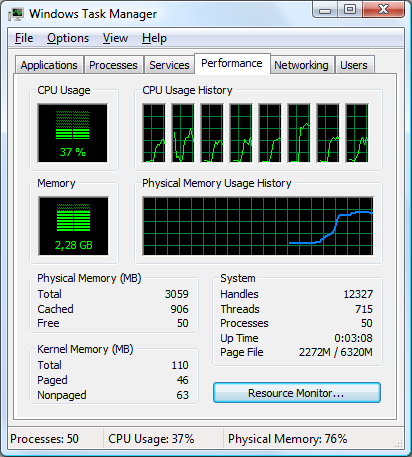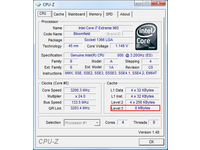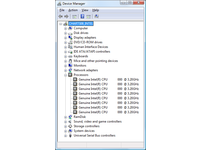UPDATE: Core i7: Blazing Fast, O/C Changes
8 MB L3 Cache And Hyper-Threading
256 KB L2-Cache and 8 MB L3 Cache
Of the many changes that Intel has made with Nehalem, the new cache structure is among the most pivotal in improving performance compared to the Core 2. The L1 cache remains unchanged, divided into 32 KB data and 32 KB instruction parts. However, where the Core 2 Duo processor sports a shared cache of up to 6 MB for its two cores, each of the four cores of the Core i7 gets its own 256 KB L2 cache. Additionally, the processor comes with 8 MB of L3 cache that is shared by all four cores.
The advantage of this configuration is that a single-threaded application has access to the full 8 MB of L3 cache. This was not possible on the Core 2 Quad processors, since their 12 MB L2 cache consisted of two halves, each located on one of the dual-core dies that made up the quad-core package.
Another advantage of the large L3 cache is that all four cores can work with a single set of data, rather than having to duplicate it across several caches; this saves space and allows more data to be kept in the cache. Exchanging data between cores also benefits from a major speed increase compared to the Core 2 CPUs with two separate caches.
Hyper-Threading
Hyper-Threading was originally introduced in the Pentium 4 / Pentium D line with its NetBurst architecture, but failed to provide any meaningful performance improvements. While it had disappeared from the desktop—the last CPU to use it was the Pentium Extreme Edition 965—it has surfaced in other chips such as the Atom.

The original intent was to improve multitasking capabilities in the desktop segment. To some extent, this worked out quite well, and was quite noticeable in everyday scenarios. In the case of current quad-core processors, Hyper-Threading has much less of an effect on their multi-threading capabilities, since they already offer enough cores to handle a large number of threads. Nonetheless, since modern applications run several threads simultaneously, they can utilize the additional virtual cores, making better use of the CPU overall.
When it introduced its Core 2 processors, Intel seemed to be saying its farewell to Hyper-Threading technology, but it has returned with the Core i7: all Core i7 models are equipped with Hyper-Threading. During our tests, only a few current applications saw marginal performance penalties. Overall, the numbers seem to confirm that the reintroduction of Hyper-Threading was a solid decision on Intel’s part. We were surprised by how many applications had a positive reaction to Hyper-Threading, showing performance gains.
Get Tom's Hardware's best news and in-depth reviews, straight to your inbox.
Current page: 8 MB L3 Cache And Hyper-Threading
Prev Page SSE 4.2 And The Technical Nitty-Gritty Next Page Memory Interface--Tri-Channel And DDR3-1600-
pullmyfoot AMD’s HyperTransport protocol can transmit up to 25.6 GB/s at 3.20 GHz.Reply
You mean Intel don't you? Other than that little mistake, good article
-
wh3resmycar hmm, question. once this nehalems come out. will we ever see a dieshrunk c2q again after the penryns? im expecting the price of this procs along with the mobo and ram to be too far off from my budget. orReply -
skywalker9952 One of the first side effects of Intel's domination of the CPU market is beginning to show. Since they don't have to compete with AMD in any market segment the i7 occupies, they have limited (significant) overclocking to only extreme models.Reply
RIP AMD.
May Abu Dhabi restore you to life soon so we don't have to suffer through more Intel ripoffs. -
sonar610 "The fastest Core i7, the 965 Extreme, is more than 2.6 times as fast as AMD’s current flagship CPU, the Phenom X4 9550 BE."Reply
This seems like an editing mistake maybe it should be 9950BE. -
cryogenic Core i7 is a great CPU, the article is not. I can't believe after all this time you still stack overclocked CPUs with unoverclocked ones. It's great to find out the overclocking potential of Nehalem but, at least include some overclocked Penryns in there too, to see how overclocked Nehalem stacks agains OTHER overclocked CPUs, because it's fairly evident that and overclocked new gen CPU will stack well with older non overclocked ones.Reply
-
joseph85 CryogenicCore i7 is a great CPU, the article is not. I can't believe after all this time you still stack overclocked CPUs with unoverclocked ones. It's great to find out the overclocking potential of Nehalem but, at least include some overclocked Penryns in there too, to see how overclocked Nehalem stacks agains OTHER overclocked CPUs, because it's fairly evident that and overclocked new gen CPU will stack well with older non overclocked ones.If it's evident then who cares?Reply -
fender22 skywalker9952One of the first side effects of Intel's domination of the CPU market is beginning to show. Since they don't have to compete with AMD in any market segment the i7 occupies, they have limited (significant) overclocking http://en.wikipedia.org/wiki/Overclocking to only extreme models.RIP AMD. May Abu Dhabi restore you to life soon so we don't have to suffer through more Intel ripoffs.Reply
My thoughts exactly... I wonder if there will be some sort of resistance to this sort of thing... It's like buying a car, you can do whatever you want to it (within the limits of the law) to make it as fast as you want. Sure, you may void your factory warranty, but it's your deal. You don't see car companies making it impossible for you to do what you want to their cars so you have to buy their expensive high end just to get your kicks... (not a perfect comparison, but it works)
I dunno, it's just pretty weak. And they are just taking advantage of the situation... -
cangelini sonar610"The fastest Core i7, the 965 Extreme, is more than 2.6 times as fast as AMD’s current flagship CPU, the Phenom X4 9550 BE." This seems like an editing mistake maybe it should be 9950BE.Reply
Fixed, thanks! -
onearmedscissorb Aside from the all too prevalent and potentially misleading typos, which someone needed to get a handle on as of months ago, I must say that the overall quality of this article is MUCH better than pretty much anything I can remember of the last few months. It's actually informative and thought out, rather than being a mess of assumptions that many people reading already know better than.Reply
Keep it up, and maybe I'll pay attention to this site like I used to.
But just for the record, I don't believe that it's particularly appropriate to use the overall average performance percentages as a basis for comparison between the "speed" of Core 2 vs. Core i7. Obviously, most people are going to be interested in the difference with games, where it's likely to be pretty minimal. But here and there, you have something like the 55% WinRAR difference pretty much skewing what otherwise would have been an accurate depiction of average expectations across the board.

